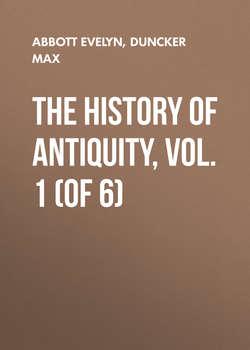The History of Antiquity, Vol. 1 (of 6)

Реклама. ООО «ЛитРес», ИНН: 7719571260.
Оглавление
Duncker Max. The History of Antiquity, Vol. 1 (of 6)
PREFACE. TO THE ENGLISH EDITION
BOOK I. EGYPT
CHAPTER I. THE LAND AND THE PEOPLE
CHAPTER II. THE ANTIQUITY OF THE CIVILISATION IN THE VALLEY. OF THE NILE
CHAPTER III. THE RELIGION OF THE EGYPTIANS
CHAPTER IV. THE KINGDOM OF MEMPHIS
CHAPTER V. THE HYKSOS AND THE RESTORATION OF THE EGYPTIAN KINGDOM
CHAPTER VI. THE HOUSE OF RAMSES
CHAPTER VII. THE MONUMENTS OF THE HOUSE OF RAMSES
CHAPTER VIII. LIFE AND MANNERS OF THE EGYPTIANS
BOOK II. THE SEMITIC NATIONS
CHAPTER I. THE ANCIENT KINGDOM OF BABYLON
CHAPTER II. THE RELIGION AND SCIENCE OF THE CHALDÆANS
CHAPTER III. THE ART AND TRADE OF BABYLONIA
CHAPTER IV. THE ARABS
CHAPTER V. THE CANAANITES
CHAPTER VI. THE RELIGIOUS RITES OF THE CANAANITES
CHAPTER VII. THE ORIGIN AND DESCENT OF THE HEBREWS
CHAPTER VIII. THE HEBREWS IN EGYPT
CHAPTER IX. THE LIBERATION OF THE HEBREWS
CHAPTER X. THE HEBREWS IN THE DESERT
CHAPTER XI. THE HEBREW INVASION OF CANAAN
CHAPTER XII. THE NATIONS OF ASIA MINOR
Отрывок из книги
History knows nothing of her infancy. The beginning of the development of the human race lies beyond the sphere of memory, and so also do the first steps in that development. The early stages of culture – whether in nations or individuals – are unconscious, and unobservant of self; they are therefore without the conditions which make remembrance possible. The original forms of social life in the family and in the tribe, the movement of wandering hunters and shepherds, the earliest steps in agriculture, could leave behind them neither monuments nor records. It is true no gifted or favoured nation, which has raised itself above these beginnings to civic life and independent culture, has neglected to cast a backward glance upon the history of its past. Everywhere the attempt has been made to present the past from the later point of culture. Whether the memory reaches but a little way, or goes back far into the past, it is always enriched by ideas taken from religious conceptions, or national pride, from reflection or theory. Such reconstructions are significant of the nature and character of the people for whom they replace the history of their youth, but they have no claim to represent the actual course of their development. The case is different when the growing culture of a people is observed by nations already at a higher grade of civilisation. The Romans were in a position to leave behind a picture of the youthful German tribes; the Byzantines could inform us of the movements of the Slaves; modern Europe could observe the tribes of America, the nomadic shepherds of Asia, and the islanders of the South Sea from a higher and riper point of development.
The oldest kingdoms of which tradition and monuments preserve any information passed unobserved through the earliest stages of their culture. Tradition and the earliest monuments present them already in the possession of a many-sided and highly-developed civilisation. In what way these nations, the oldest representatives of the culture of mankind, arrived at their possession, we can only deduce from such evidence as is before us anterior to tradition and independent of it – from the nature of the regions where these civilisations sprung up, from the physical character and constitution of the nations which developed them, from their languages and their religious ideas.
.....
Like the embalmment and the tomb, the cerements and the coffin were more or less costly, according to the rank and wealth of the deceased. The dead person was placed in a receptacle adapted to the shape of the corpse, provided with a mask to represent his face, and adorned with inscriptions and pictures. On the breast was generally depicted the beetle of Ptah, or an open eye, the symbol of Osiris. This receptacle was then placed in two or more coffins, each inclosing the other, which were made of more or less costly wood. Rich persons added to their coffins the stone sarcophagus, a hollow block of granite, the heavy lid of which was then made so fast to the lower part that it could not be opened without destroying the whole.
The sarcophagus was carried to the sepulchre in solemn procession, led by the temple-servants, with the necessary implements, and the bull destined for sacrifice to the dead. Next were seen the implements used by the deceased in his lifetime; the insignia of his order, if he had been a priest, or in any office; or, if he had held any military command, his chariot followed. After this came the waiting-women, hired for this purpose according to the custom of the East; and men with palm-branches, the servants of the dead, and the priests; last of all followed the sarcophagus on a boat – for the soul of the dead passed like the sun-god on a boat to the under world. This boat was on rollers, and drawn by oxen. The procession was closed by the mourners of the family and the friends. When the bull had been sacrificed and frankincense burned to the gods, libations were poured in honour of the dead. He was praised, as Diodorus assures us, not because he was born of a noble race, but because he had been carefully educated and well instructed, because he had been pious towards the gods, and had lived a just and sober life. Then the kinsfolk implored the gods to receive the dead into the society of the good. The accompanying multitude joined in the prayer, and extolled the faith of the deceased, who now would for ever pass his life in the company of the good.117 The coffin was then brought into the upper chamber, and from thence, when the ceremonies were completed, it was carried to its proper resting-place, and placed on the west side of it; the place was then closed and sealed.
.....